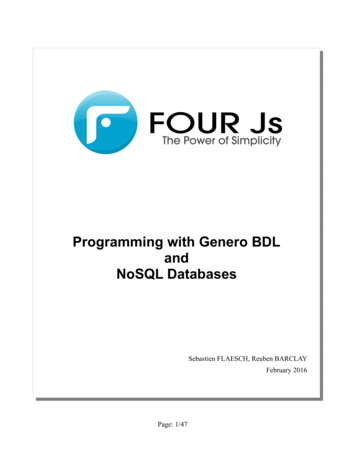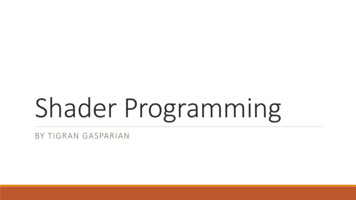
Transcription
Shader ProgrammingBY TIGRAN GASPARIAN
Who am I?Name: Tigran GasparianAge: 22Master student Game and Media TechnologyWorking on a game for almost two years already The Flock – multiplayer horror game Like us on Facebook! Doing a lot of graphics programming in Unity
Table of contentsIntroduction and motivationGraphics pipelineVertex shader introPixel shader introWriting shaders in XNATips & Tricks
What are shaders?Programs that run on the graphics card Somewhat limited compared to languages like C# Because of these limitations, very good at certain tasks Perform some of the computations necessary for graphicsWe’ll cover pixel and vertex shaders Geometry, Tessellation and Compute shaders not covered here.Written in some shading language HLSL, GLSL, CG, PSSL, MSL, etc. We’re going to use HLSL – High Level Shading LanguageNode-based editor
What are shaders?
Why learn to write shaders?Game engines come with lots of built-in shaders
Why learn to write shaders?Create a unique look and feel for your game Want something never done before? Do it yourself!Implement state of the art techniques The latest and greatest techniques don’t have standard implementations yet.Unlock the infinite powers of the GPU! Well, not infinite, but it’s certainly powerful.14x speedup according to Intel300x speedup according to NVIDIADepends on the application.
Why learn to write shaders?It helps you pass the second practicum.
The Graphics PipelineWhat is the graphics pipeline? A sequence of actions that is performed to render a 2D imagefrom a 3D sceneWe’ll cover the following stages: Vertex Shader Rasterizer Can’t be programmed, but it’s an important stage Pixel ShaderWill be covered in-depth in the next lecture.
The Graphics PipelineVertex data resources graphics card image!What is vertex data? Mostly trianglesWhat kind of resources? Textures Global variables Like the light color Lots of other stuff we won’t cover.We first set the resources, then we push the vertices to thegraphics card
The Vertex ShaderPerform some computations per vertex. Can move the positions of vertices. Usually transforms vertices Using the World, View and Projection matrices
The Vertex ShaderPerform some computations per vertex. Can move the positions of vertices. Usually transforms vertices Using the World, View and Projection matrices Other deformations
The RasterizerTurns triangles into pixels!Interpolates vertex data More about this later
The Pixel ShaderPerform computations per pixel More accurate than per-vertex computations Can’t change the shape of the geometry Vertex shaders can!Common uses Texture mapping We need to sample the texture for every pixel Per pixel lighting
The Vertex Shader – In-DepthWhat’s a vertex shader? Just a function called for every vertexInput: Vertex data A struct containing vertex information Let’s call it: VertexShaderInputOutput: A struct Can contain anything Let’s call it: VertexShaderOutputObservation: Vertex shader doesn’t know about triangles
The Vertex Shader – VertexShaderInputstruct VertexShaderInput{float4 Position : POSITION0;float4 Color : COLOR0;float2 TextureCoordinate : TEXCOORD0;float SomeCustomData : TEXCOORD1;};The data sent from the CPU to the GPUHLSL codeLooks like C New data types Input semantics
The Vertex Shader – VertexShaderOutputstruct VertexShaderOutput{float4 Position : POSITION0;float4 Color : COLOR0;float3 VertexPosition : TEXCOORD0;};Must have member with POSITION0 semantic Contains vertex position transformed to normalized device coordinates
Sidetrack #1 - Input semanticsRequired for interaction with C# code More on this laterLots of remnants from the fixed function pipeline era.Lots of semantics POSITION[n] TEXCOORD[n] (e.g. TEXCOORD0, TEXCOORD1, etc.) Use this for all custom data COLOR[n] Clamped between 0 and 1 NORMAL[n] Many more
Sidetrack #2 - HLSL Data typesHLSL has some specialized data types float – nothing specialfloat2 – 2D vectorfloat3 – 3D vectorfloat4 – 4D vector float4x4 – 4x4 float matrix float2x3 – 2x3 float matrix Same thing with half – 16 bit floatsfixed – 8 bit floatsint – 32 bit integeretc.
Sidetrack #3 - HLSL Data typesfloat3 position float3(0, 0, 0);float3 direction float3(1, 2, 1.2f);float someValue 5;position direction * someValue;float yDirection direction.y;float2 xyDirection direction.xy;Works mostly like you’d expect it to.We’ll cover more HLSL later on
The Graphics PipelineWe just covered the Vertex ShaderOutput:struct VertexShaderOutput{float4 Position : POSITION0;float4 Color : COLOR0;float3 VertexPosition : TEXCOORD0;};
The Graphics PipelineWe just covered the Vertex ShaderOutput:struct VertexShaderOutput{float4 Position : POSITION0;float4 Color : COLOR0;float3 VertexPosition : TEXCOORD0;};Input for Rasterizer
The RasterizerConverts triangles into pixels Or: Rasterizes triangles
The RasterizerConverts triangles into pixels Or: Rasterizes trianglesInterpolates values between vertices For example the colorsstruct VertexShaderOutput{float4 Position : POSITION0;float4 Color : COLOR0;float3 VertexPosition : TEXCOORD0;};
The Rasterizer – Linear InterpolationValues in the vertex structures are linearly interpolatedfloat LinearInterpolate(float a, float b, float t){return (1 - t)*a t*b;}Weighted averageCan also be done with vectors and colors Interpolating vectors does not preserve length Renormalize your normals after interpolation!
The Rasterizer – Interpolating vectorsCan also be done with vectors and colors Interpolating vectors does not preserve length Renormalize your normals after interpolation!Notice what happens when we interpolate between the blue and red vectors
The Graphics PipelineAfter the rasterizer stage, we end up with pixels.struct VertexShaderOutput{float4 Position : POSITION0;float4 Color : COLOR0;float3 VertexPosition : TEXCOORD0;};
The Graphics PipelineAfter the rasterizer stage, we end up with pixels.struct VertexShaderOutput{float4 Position : POSITION0;float4 Color : COLOR0;float3 VertexPosition : TEXCOORD0;};For every pixel, we get a VertexShaderOutput struct With POSITION0 field removed
The Pixel Shader – In-DepthWhat’s a pixel shader? Just a function called for every pixelInput: Interpolated Vertex Shader Output We reuse the struct VertexShaderOutput POSITION0 field “eaten” by the rasterizerOutput: One or more colors (or depth) We can put this in a struct Or just output a float4
The Pixel Shader – PixelShaderOutputstruct PixelShaderOutput{float4 color : COLOR0;};COLOR0 semantic is mandatoryAnd that’s it!
Simple example – Vertex Color shaderWalkthrough for a simple shaderVertex shader: Transform cube with World, View and Projection matrix Pass vertex colors to rasterizerPixel shader Output interpolated vertex colors
Simple example – Vertex Color shaderstruct VertexShaderInput{float4 Position : POSITION0;float4 Color : COLOR0;};struct VertexShaderOutput{float4 Position : POSITION0;float4 Color : COLOR0;};float4x4 World;float4x4 View;float4x4 Projection;
Simple example – Vertex Color shaderVertexShaderOutput VertexShaderFunction(VertexShaderInput input){VertexShaderOutput output;float4 worldPosition mul(input.Position, World);float4 viewPosition mul(worldPosition, View);output.Position mul(viewPosition, Projection);output.Color input.Color;return output;}
Simple example – Vertex Color shaderstruct PixelShaderOutput{float4 color : COLOR0;};PixelShaderOutput PixelShaderFunction(VertexShaderOutput input){PixelShaderOutput output;output.color input.Color;return output;}
Simple example – Vertex Color shaderfloat4 PixelShaderFunction(VertexShaderOutput input) : COLOR0{return input.Color;}
Simple example – Vertex Color shaderTell the compiler which functions are the vertex shader and the pixel shaderTechnique A shader file consists of one or more techniques (e.g. effect)Pass Every technique consists of one or more passes Every pass consists of a vertex shader and a pixel shader
Simple example – Vertex Color shadertechnique VertexColorsTechnique{pass FirstPass{VertexShader compile vs 2 0 VertexShaderFunction();PixelShader compile ps 2 0 PixelShaderFunction();}}We choose a vertex shader and pixel shader profile Lower profile – 2 0 – less capabilities, supports older graphics cards Higher profile – 3 0 – more capabilities, only supports more recent graphics cards
Simple example – Vertex Color shaderThat’s it! Not that much code!
Simple example – Vertex Color shaderfloat4x4 World;float4x4 View;float4x4 Projection;VertexShaderOutput VertexShaderFunction(VertexShaderInput input){VertexShaderOutput output;struct VertexShaderInput{float4 Position : POSITION0;float4 Color : COLOR0;};struct VertexShaderOutput{float4 Position : POSITION0;float4 Color : COLOR0;};float4 worldPosition mul(input.Position, World);float4 viewPosition mul(worldPosition, View);output.Position mul(viewPosition, Projection);output.Color input.Color;return output;}float4 PixelShaderFunction(VertexShaderOutput input) : COLOR0{return input.Color;}technique VertexColorsTechnique{pass FirstPass{VertexShader compile vs 2 0 VertexShaderFunction();PixelShader compile ps 2 0 PixelShaderFunction();}}
Using shaders in XNAVertex declarationsLoading shadersSetting global variablesRendering
Vertex DeclarationsYou’ve probably used this in P1private VertexPositionColor[] vertices;Later in P1, you define your own vertex types (see Section 7.2 of P1)private VertexPositionColorNormal[] vertices;
Vertex DeclarationsIn the vertex declaration, we see this:public static VertexElement[] VertexElements {new VertexElement(0, VertexElementFormat.Vector3, VertexElementUsage.Position, 0),new VertexElement(sizeof (float)*3, VertexElementFormat.Color, VertexElementUsage.Color, 0),new VertexElement(sizeof (float)*3 4, VertexElementFormat.Vector3, VertexElementUsage.Normal, 0),};Relates to the following shader code:struct VertexShaderInput{float3 Position : POSITION0;float4 Color : COLOR0;float3 Normal : NORMAL0;};
Vertex DeclarationsIn the vertex declaration, we see this:public static VertexElement[] VertexElements {new VertexElement(0, VertexElementFormat.Vector3, VertexElementUsage.Position, 0),new VertexElement(sizeof (float)*3, VertexElementFormat.Color, VertexElementUsage.Color, 0),new VertexElement(sizeof (float)*3 4, VertexElementFormat.Vector3, VertexElementUsage.Normal, 0),};Relates to the following shader code:struct VertexShaderInput{float3 Position : POSITION0;float4 Color : COLOR0;float3 Normal : NORMAL0;};
Vertex DeclarationsIn the vertex declaration, we see this:public static VertexElement[] VertexElements {new VertexElement(0, VertexElementFormat.Vector3, VertexElementUsage.Position, 0),new VertexElement(sizeof (float)*3, VertexElementFormat.Color, VertexElementUsage.Color, 0),new VertexElement(sizeof (float)*3 4, VertexElementFormat.Vector3, VertexElementUsage.Normal, 0),};Relates to the following shader code:struct VertexShaderInput{float3 Position : POSITION0;float4 Color : COLOR0;float3 Normal : NORMAL0;};
Vertex DeclarationsIn the vertex declaration, we see this:public static VertexElement[] VertexElements {new VertexElement(0, VertexElementFormat.Vector3, VertexElementUsage.Position, 0),new VertexElement(sizeof (float)*3, VertexElementFormat.Color, VertexElementUsage.Color, 0),new VertexElement(sizeof (float)*3 4, VertexElementFormat.Vector3, VertexElementUsage.Normal, 0),};Relates to the following shader code:struct VertexShaderInput{float3 Position : POSITION0;float4 Color : COLOR0;float3 Normal : NORMAL0;};
Vertex DeclarationsIn the vertex declaration, we see this:public static VertexElement[] VertexElements {new VertexElement(0, VertexElementFormat.Vector3, VertexElementUsage.Position, 0),new VertexElement(sizeof (float)*3, VertexElementFormat.Color, VertexElementUsage.Color, 0),new VertexElement(sizeof (float)*3 4, VertexElementFormat.Vector3, VertexElementUsage.Normal, 0),};Relates to the following shader code:struct VertexShaderInput{float3 Position : POSITION0;float4 Color : COLOR0;float3 Normal : NORMAL0;};
Creating shader fileRight click on Content Project Add - New Item
Creating shader fileRight click on Content Project Add - New Item Visual C# - Effect File
Setting up the shaderLoad the shader like any other resourceEffect effect Content.Load Effect ("ExampleShader");Set the active techniqueeffect.CurrentTechnique effect.Techniques["VertexColorsTechnique"];Set shader global );
Rendering using the shaderforeach (EffectPass pass in effect.CurrentTechnique.Passes){pass.Apply();// Rendering code here}
Rendering using the shaderforeach (EffectPass pass in effect.CurrentTechnique.Passes){pass.Apply();// Rendering code tiveType.TriangleList,vertices, 0, vertices.Length, indices, 0, indices.Length/3);}
In the draw ;foreach (EffectPass pass in effect.CurrentTechnique.Passes){pass.Apply();// Rendering code tiveType.TriangleList,vertices, 0, vertices.Length, indices, 0, indices.Length/3);}That’s it!
HLSL tips and tricksSome useful things to know about HLSLJust a quick glance, google it for details
Useful functions in HLSLVector length float len length(myVector);Normalize vector myNormal normalize(myNormal);Cross product float3 crossProduct cross(forward, up);Dot product float intensity dot(normal, lightDirection);Clamp value between [3,5] int x clamp(y, 3, 5);Clamp value between [0,1] int x saturate(y); In some cases, this function is free!
Useful functions in HLSLOther functions: abs, min, max, sin, cos, tan, pow, sqrt, exp, log, floor, lerp, smoothstep, reflect, refract, and many more.Most common math functions are availableJust Google for ‘HLSL function name’ or ‘CG function name’
Sampling textures in HLSLDefine a texture global variable Texture2D MyTexture; Set its value in C#.Then we define a texture samplersampler2D MySampler sampler state{texture MyTexture ;magfilter LINEAR;minfilter LINEAR;mipfilter LINEAR;AddressU mirror;AddressV mirror;};
Sampling textures in HLSLNow we need to ‘read’ the texture This is called sampling Lots of ways to do itSample function in HLSLfloat4 color tex2D(MySampler, float2(0.2, 0.3));Note that we pass the sampler, not the texture.Texture coordinates [0,1] range Usually you’d pass a variable (like interpolated texture coordinates)Returns a float4
Sampling textures in HLSLLots of sampling functions available But you won’t need most of theseAnd these aren’t the only ones!tex2Dtex2Dbiastex2Dgradtex2Dlodtex2Dproj
Sampling textures in HLSL1D Textures2D Textures3D TexturesCubemapsAll of these have their own sampling functions tex1D, tex2D, tex3D, texCUBE
SwizzlingTake a look at the following codefloat4 a;float4 b;a b.wyzx;You can also reuse componentsfloat4 a;float4 b;a b.wyyx;Or reuse one components four timesfloat4 a;float4 b;a b.xxxx;
SwizzlingGenerate a 2D vector from a 4D vectorfloat2 a;float4 b;a b.xz;Or a 4D vector from a 2D vectorfloat4 a;float2 b;a b.xxyy;Instead of .xyzw, we can also use .rgbafloat4 a;float4 b;a b.rgba;
Common errorsYou’ve forgotten a semicolon ERROR: Unexpected token ‘something’ Take a look at the line before the errorYou misspelled variable names in C# Shader parameters and technique names are all CASE Sensitive!Mesh doesn’t show up It’s probably the cullmodeOr your World MatrixOr your View MatrixOr your Projection MatrixOr some other render stateOr I don’t know, it’s your code!
Common errorsDebugging shaders is hard Certainly harder than the CPU Can’t step through code, add breakpoints, etc. Can’t Console.WriteLine valuesAll is not lost though! Just don’t write any errors.
Common errorsStart with very simple shaders Don’t write everything and test it afterwards. Use a very simple pixel shader to write your vertex shaderfloat4 PixelShaderFunction(VertexShaderOutput input) : COLOR0{return float4(1,0,0,0);} Make sure you test all the code you write. Lots of sanity checks! If you’ve finished with your vertex shader, write simple pixel shaders to test all the input Returning colors is kind of like Console.WriteLine()float4 PixelShaderFunction(VertexShaderOutput input) : COLOR0{return float4(input.Normal,0);}
Common errorsDocument every line of code It’s not that many lines of code anyway!Use proper variable naming Indicate global variablesIf a vector is a normalized vector, call it myVectorNIf a vector is in world space, call it positionW or positionWorld or worldPosition, just indicate it.Same thing with view spaceSame thing with projected coordinatesIf a vector points to the camera, call it toCamera, if it’s pointing to the camera and is normalized, call ittoCameraNIf there’s a built-in function for it, use it!Test your vertex declaration Often the semantics in the C# vertex declaration and the HLSL struct don’t match
Help, my shader was working and nowit’s not working anymore!Changed your shader code? Well, there’s your problemChanged C# code? Some render state probably changed.Render states changed by SpriteBatchGraphicsDevice.BlendState tate ate e.SamplerStates[0] SamplerState.LinearClamp;You’ll need to change it back, even though you didn’t set it explicitly in the first placeGraphicsDevice.BlendState BlendState.Opaque;GraphicsDevice.DepthStencilState DepthStencilState.Default;
Help, my shader was working and nowit’s not working anymore!Some other shader may also have changed the render states Check this firstSome global variables might be incorrect Example:Render object 1 with a 100x scaling matrixForget to set the world matrix back to 1x scalingRender object 2, which is so big, it gets clipped awayYou can check these values easily in C#
The EndANY QUESTIONS?
Buy The Flock!
The EndANY QUESTIONS?
Somewhat limited compared to languages like C# Because of these limitations, very good at certain tasks Perform some of the computations necessary for graphics Well cover pixel and vertex shaders Geometry, Tessellation and Compute shaders not covered here. Written
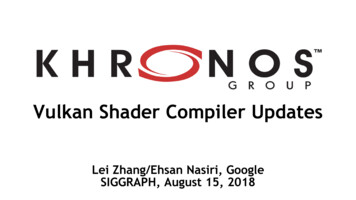




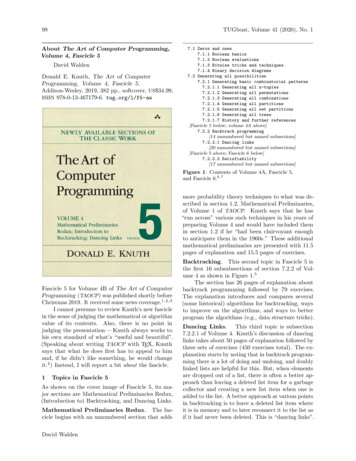

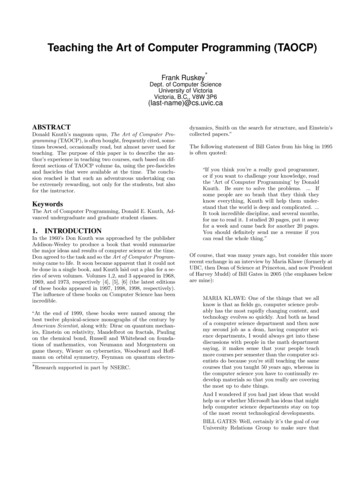


![Fluent Python : [clear, concise, and effective programming]](/img/1/799981060.jpg)
